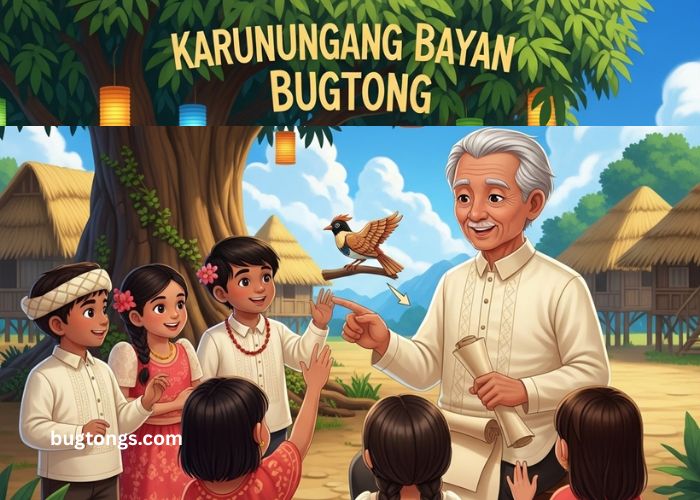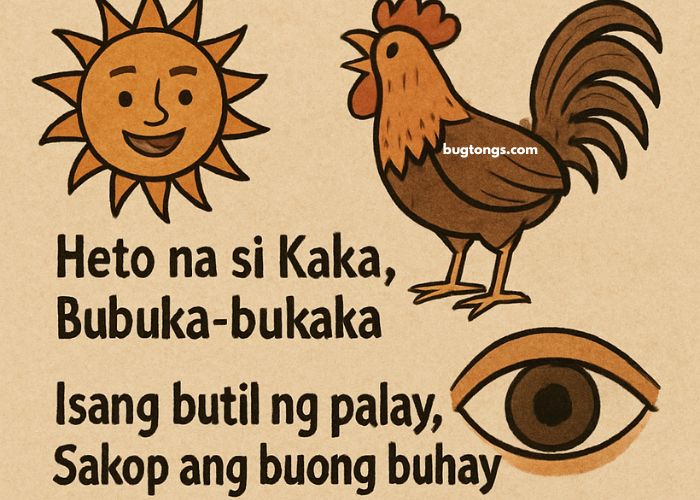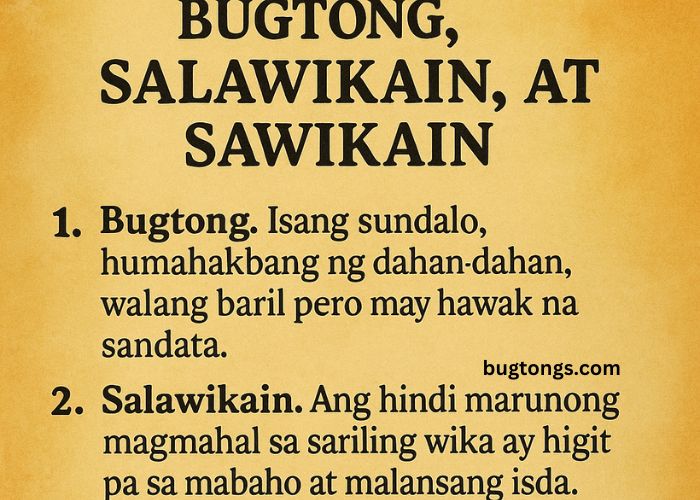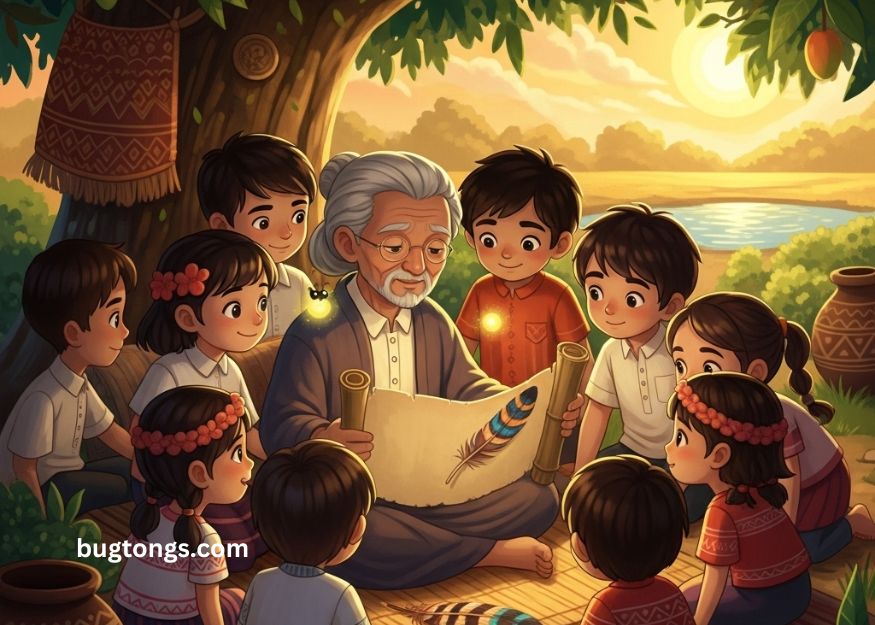Karunungang bayan bugtong means “Filipino riddles.” These riddles are fun and smart. They make us think. They are like puzzles but in words. Many kids and even adults like them. People play these riddles in school, at home, and during games.
Each bugtong is short. It is like a poem. It talks about something, but it hides the answer. You need to guess the right answer. It helps our brain. It helps us learn more words.
Thousands of years ago, grandparents were using these riddles to spend their leisure time. They used to play with their children. These bugtong are part of Filipino culture. By playing these riddles, we can learn about our culture and enjoy ourselves also.
3 Key Points:
- Karunungang bayan bugtong are riddles.
- They are fun and easy to say.
- They help us think and learn.
What Is Karunungang Bayan Bugtong?
A karunungang bayan bugtong is a short riddle. It is a question in the form of a poem. It has hidden meaning. You have to think deeply to find the answer. It is fun and makes you smart. When you try to find the answer to the question, you will use your brain. You will read the question carefully and think about the answer. That makes you intelligent.
Many people in the Philippines use bugtong. They are part of Filipino culture. We say them when we are happy. We say them at parties and school games.
Here is an example:
“Hindi tao, hindi hayop, kung uminom ay salup-salop.”
(Answer: poso or water pump)
The riddle talks about something we see every day. It gives clues. You must guess what it is.
Another one:
“May bintana ngunit walang bubong.”
(Answer: ilong or nose)
These riddles use easy words. But the answer is not always easy. You have to think carefully. That is why bugtong is fun.
Note: Karunungang bayan bugtong are part of our old Filipino traditions. They are passed from one person to another.
Why Do We Use Karunungang Bayan Bugtong?
We use karunungang bayan bugtong for many reasons. First, they are fun! Kids love to say them. Adults like to guess. It’s a happy game.
Second, they help us learn. Bugtong make our brain work. We think and guess. It helps us become smart.
These bugtong are part of the tradition of Filipino culture. From the very beginning of the culture, people were using it to spend their good time with their family members. We use it because these will remember us about our tradition.
Some teachers use bugtong in class. It helps students listen, speak, and think. It is also a way to teach Filipino words.
Here is a table to show why bugtong is good:
| Reason to Use Bugtong | What It Helps With |
| It is fun | Makes people happy |
| It helps you think | Brain exercise |
| It teaches new words | Better Filipino skills |
| It shows culture | Love for traditions |
| It builds friendships | Group games and sharing |
Bugtong is not just a game. It is also a way to learn and grow.
Examples Of Karunungang Bayan Bugtong
There are many bugtong. Some are easy. Some are hard. All of them are fun.
Here are a few examples:
- “Isang butil ng palay, sakop ang buong bahay.”
(Answer: ilaw or light bulb)
- “Buto’t balat lumilipad.”
(Answer: saranggola or kite)
- “Bahay ng gagamba, wala namang bubong.”
(Answer: sapot or web)
- “Hindi tao, hindi hayop, nagsusuot ng sumbrero.”
(Answer: kabute or mushroom)
- “May leeg, walang ulo. May tiyan, walang dumi.”
(Answer: bote or bottle) - May bintana na, wala namang bubong.
Sagot: Ilong - Lumuluha walang mata, naglalakad walang paa.
Sagot: Gripo - Buto’t balat, lumilipad.
Sagot: Saranggola - Isang butil ng palay, sakop ang buong bahay.
Sagot: Ilaw - May tiyan, walang bituka.
Sagot: Bote - Hindi tao, hindi hayop, kung uminom ay salop-salop.
Sagot: Poso - May paa, pero hindi nakakalakad.
Sagot: Mesa - Nagtago si Pedro, labas ang ulo.
Sagot: Pako - Kapatid ng iyong ama, tumutulong sa iyong ina.
Sagot: Tiyuhin - Aba’t batang maliit, kung umakyat ay baliktad.
Sagot: Gagamba - Bahay ng gagamba, wala namang bubong.
Sagot: Sapot - Maliit pa si Neneng, marunong nang manahi.
Sagot: Karayom - May dalawang magkaibigan, laging nag-uusap, pero di nagkikita.
Sagot: Tainga - Bahay ko sa gitna ng dagat, may mga palong ang bubong.
Sagot: Alimango - May balbas, pero walang mukha.
Sagot: Mais - Hindi tao, hindi hayop, may ngipin pa.
Sagot: Susi - Nagbibigay ng liwanag, hindi araw, hindi kandila.
Sagot: Ilaw sa kisame - Ulo’y may buhok, katawan ay kahoy.
Sagot: Walis - Araw-araw dumadaan, pero hindi mo mahawakan.
Sagot: Hangin - Dalawang batong itim, malayo ang nararating.
Sagot: Mata - Ulo’y makinis, buntot ay matulis.
Sagot: Lapis - Hindi pari, hindi hari, pero suot ay sarisari.
Sagot: Sampayan - Heto na si Kaka, bubuka-bukaka.
Sagot: Gunting - Kung kailan mo pinatay, saka pa humaba ang buhay.
Sagot: Kandila - May leeg, walang ulo. May tiyan, walang dumi.
Sagot: Bote - Nagbibigay ng gatas, hindi baka, hindi tao.
Sagot: Niyog - Isang bayabas, pito ang butas.
Sagot: Ulo - May dila, walang bibig.
Sagot: Tsinelas - May mga mata, pero hindi nakakakita.
Sagot: Gamit na karayom o butas ng salakot - Ako’y may alagang hayop, nakalagay sa loob ng papel.
Sagot: Lapis (ang hayop ay “pusa” sa lapis, o pantasa)
Each bugtong gives clues. It hides the answer. You think. You guess. That’s the fun part!
How To Make Your Own Karunungang Bayan Bugtong
You can also make your own karunungang bayan bugtong. When you play these riddles you will be so smart and intelligent. You will know how to solve a puzzle, how to think. From that point you will be able to make your own riddles. It is easy. If you want to make your own riddles you can think in these way:
- At first think about something around you. It can be anything.
- Explain that thing in a funny way with rhyme. But do not give the right answer. Just give clue.
- Make it sound like a poem.
Let’s try.I am giving you a topic, ‘’Think of a toothbrush’’
You can say:
“Ako ay may buhok, pero di pwedeng suklayin.”
(Answer: toothbrush)
You can do more. Try fruits, toys, or animals. Use simple words. Make it rhyme if you can.
Reminder: When you make bugtong, think about Filipino life. Use things we see around us.
Why Bugtong Is Important Today
Karunungang bayan bugtong is still important today. We live in a modern world. But these riddles keep our old ways alive. We will remember about our root.
Most of the children are using phones and gadgets. But bugtong is a simple, happy game. No phone needed. Just your brain!
Bugtong also helps in school. Teachers use them for reading and speaking. They also teach teamwork. Bugtong builds memory. It teaches us to listen. It makes learning fun.
Here are the benefits of bugtong:
- Easy and fun to play
- Helps improve language
- Great for family and school time
- Keeps our Filipino culture alive
Let us continue to use and share these riddles. Let us keep our karunungang bayan bugtong alive.
Conclusion
So you have learned that Karunungang bayan bugtong is a gift from our old Filipino stories. These bugtong are short, easy, and funny. You can learn so many words by playing these games. Though these bugtong are short, they teach you a lot of things. They help us think. They help us speak.
We must not forget them. Let us share them with others. Let us use them in school, home, and games. So next time, say a bugtong. Let someone guess. Laugh together. Learn together. That is the joy of karunungang bayan bugtong.
FAQs
- What is a bugtong?
A bugtong is a Filipino riddle or puzzle using words. - What does “karunungang bayan” mean?
It means folk wisdom or old knowledge from people. - Why do kids like bugtong?
Kids are love to play bugtong because these are funny, short, and easy. - Can I make my own bugtong?
Yes! Just think of something and write clues about it. - Where do people say bugtong?
At home, in school, during games, or parties. - Are bugtong good for learning?
Yes! They help you think and learn new words. - Do all bugtong have answers?
Yes, but some are tricky. You must think carefully. - Can adults enjoy bugtong too?
Yes! Bugtong is for kids and adults. - How old is bugtong in the Philippines?
Bugtong are very old culture. Our great-grandparents used them long ago. - Is bugtong still used today?
Yes! Many schools and families still use them.




